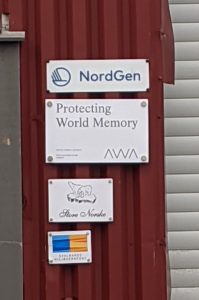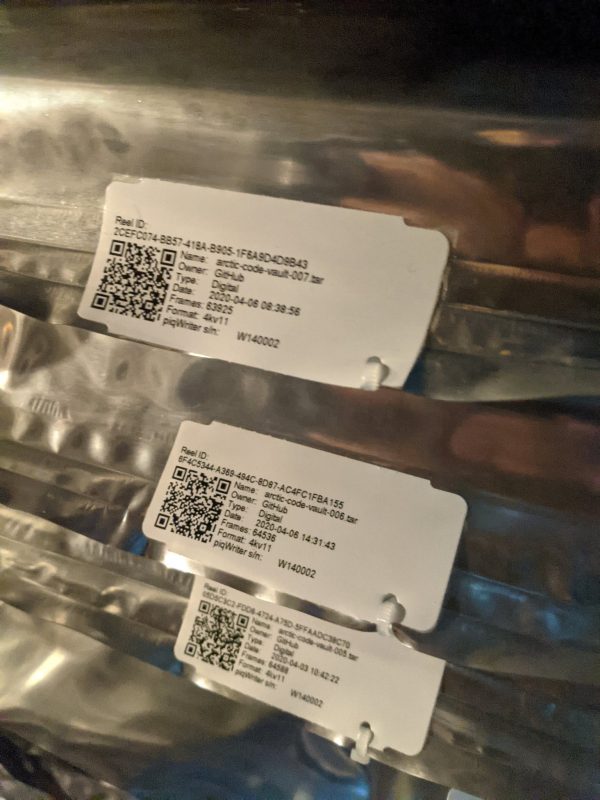Arctic World Archive Resists to Pandemic
Piql just did deposit ceremony in Svalbard archipelago.
By Philippe Nicolas | September 28, 2021 at 2:03 pmPiql organized a few days ago a new deposit ceremony in the Arctic World Archive (AWA) in Longyearbyen in the Svalbard archipelago.
This event was the first for 2021 due to the pandemic with several Norwegian deposits, Indira Gandhi ministry of Culture in India, the national library of Hungari and Progettali from Italy among others.

Started as Cinevator, Piql was founded in 2002 in Drammen, Norway, to address the growing need of long-term data preservation with a radical new approach. For such requirement, you need a media that lasts long, very long, a format on it, some elements to generate data and read them later and guarantee that this access will be possible in the future. The goal is to preserve data over several hundreds years later with favorable climate condition. And even if many of us know that one of media could be tape or other storage flavors, very often a technology refresh is mandatory every few years and it creates some complexity over time. So Piql is a technology provider developing archive product that can be used within a corporation. They also added an optional vaulting service in an unique place on the planet still based on their solution.
In their search of a media, Piql engineers eliminate magnetic media as it is sensitive to radioactivity and of course magnetic sources. This could impact the duration of the data on the media as the media itself could suffer from some damages. They decided to use a photo sensitive film as a ultra-high resolution nano-film, in a 35mm format, optimized for data preservation. Tested by official verification processes, that film has more than 500 years of projected life without any need to refresh or jump to a new media. It is also offline, key attribute with the current ransomware pressure, immutable and as mentioned is a permanent medium. They encode data with a specific process of their own, and generate very dense QR codes in 4 levels of grey with 8 millions pixels per frame all encapsulated in open source TAR sessions. Each PiqlFilm has a capacity of 120GB.

Speaking during the event with Rena Bjerkerstand, founder and managing director of Piql, we learned that the AWA was inspired by the Global Seed Vault project started in 2008 that used coal mine #7 a few hundreds meters from the airport well below the permafrost in a very stable location with specific temperature, humidity, seismic and others characteristics. Piql has imagined a similar approach to store and preserve digital data over long time with a special approach. They use also a decommissioned coal mine, in that case mine #3, with a special zone in it, completely remodeled we mean reshaped to host a container, similar to cargo ones, and inside in a hermetic bag, the PiqlFilm placed in the reel and in a PiqlBox. External recognition of the data entity is made with metadata written in the bag itself as it is shown below with GitHub examples.

As of today, it seems that the AWA container contains more than 450 PiqlFilm that represents more than 50TB and around half of them belongs to GitHub. As the first container is full, we anticipe very soon a second one in the same zone.
For some of you who know the place, the seed vault and the AWA mine are located below a plan field of top of the mountain with hundreds and satellites antennas. This place is unique.
We took time to ask Piql executive what is his next phase and in total transparency, Bjerkerstand told us that they’re working on a SaaS offering named PiqlConnect, being an online service to submit data and generate film. They also planed to deliver a mobile application to make this even more transparent and give this project a sense of ubiquity even if the archive location is “hard coded” in the mountain. The other project will be to offer the PiqlWriter and PiqlReader service directly at the entrance of the mine to deliver more data bandwidth injection and flexibility and retrieval needs. Today, the deposit inside the mine is a manual process, same thing for the data access and take times with some planning around these.
And finally for those of you who wish to get live informations, we recorded an interview of Rune Bjerkestrand, Piql managing director, during our stay in Svalbard. You can listen to this episode here posted on The French Storage Podcast web site.
Obviously we have to mention other storage projects that targets fixed or reference data based on DNA, holographic, optical or glass.














 Subscribe to our free daily newsletter
Subscribe to our free daily newsletter

